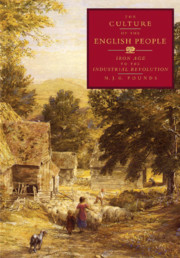Book contents
- Frontmatter
- Contents
- List of illustrations
- List of tables
- Preface
- List of abbreviations
- Map of traditional counties, with abbreviations, as used in this book
- Introduction
- 1 The view from Danebury
- 2 Roman interlude
- 3 House and household
- 4 Heat, light and insecurity
- 5 The house furnished
- 6 Food, its production, preservation and preparation
- 7 In sickness and in death
- 8 The community of parish and village
- 9 The family
- 10 The culture of cities
- 11 The foundations of popular culture
- 12 Conclusion: the end of popular culture
- Notes
- Index
4 - Heat, light and insecurity
Published online by Cambridge University Press: 06 July 2010
- Frontmatter
- Contents
- List of illustrations
- List of tables
- Preface
- List of abbreviations
- Map of traditional counties, with abbreviations, as used in this book
- Introduction
- 1 The view from Danebury
- 2 Roman interlude
- 3 House and household
- 4 Heat, light and insecurity
- 5 The house furnished
- 6 Food, its production, preservation and preparation
- 7 In sickness and in death
- 8 The community of parish and village
- 9 The family
- 10 The culture of cities
- 11 The foundations of popular culture
- 12 Conclusion: the end of popular culture
- Notes
- Index
Summary
Except in summer, the traditional house was cold and draughty, and at all times dark and gloomy. Its doors and windows admitted more air than light and gave little protection against the intruder. For most people their security lay in the paucity of goods worth stealing. People spent much of their time out of doors. Houses were for eating and sleeping, and only during the dark days of winter would people have spent much time within them. In the course of the later Middle Ages and early modern times, however, household furniture increased; domestic comforts, like cushions and curtains and decorated walls, became more common, and by small increments a house was slowly turned into a home.
The central hearth
Before the sixteenth century most homes had only a single hearth, centrally placed within the hall.
A midde the halle flor
A fier, stark and store
Was light and brende bright.
It was usually made of small stones set on edge, but sometimes of stone slabs, and occasionally of fire-hardened clay. Here a fire smouldered and was rarely allowed to go out because there was no ready means of lighting it again. Should it be extinguished, it had generally to be relighted with embers carried from a neighbouring house. This was a hazardous undertaking, and the rolls of the coroners's courts occasionally contain references to the disastrous consequences of the careless handling of a burning brand.
- Type
- Chapter
- Information
- The Culture of the English PeopleIron Age to the Industrial Revolution, pp. 109 - 135Publisher: Cambridge University PressPrint publication year: 1994



